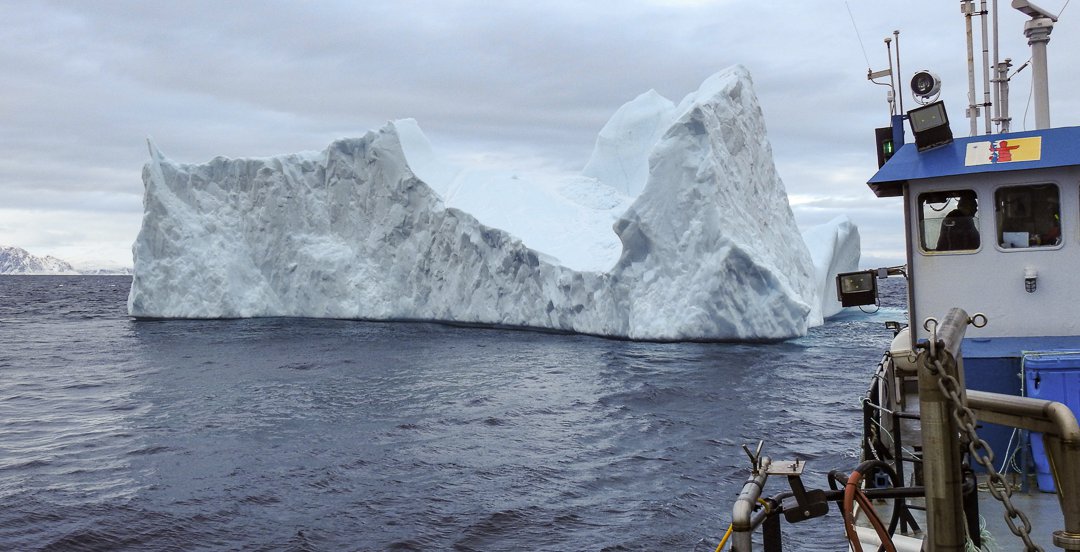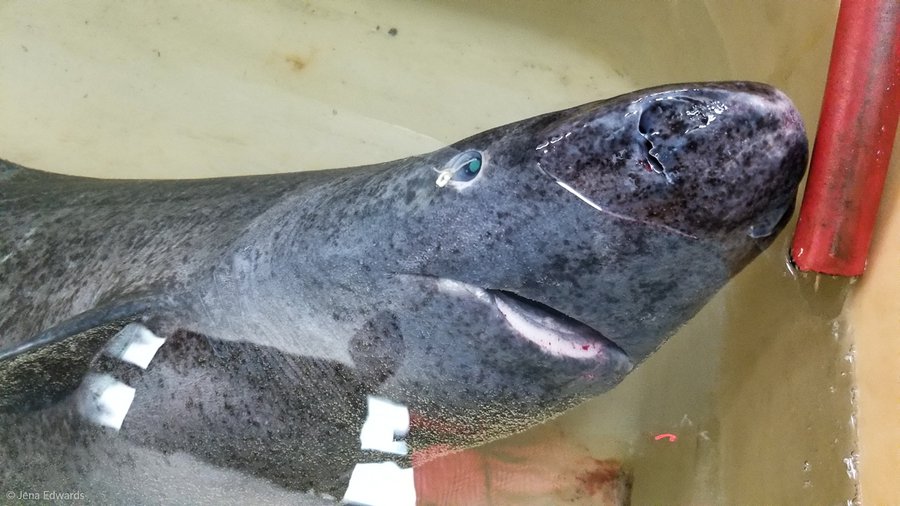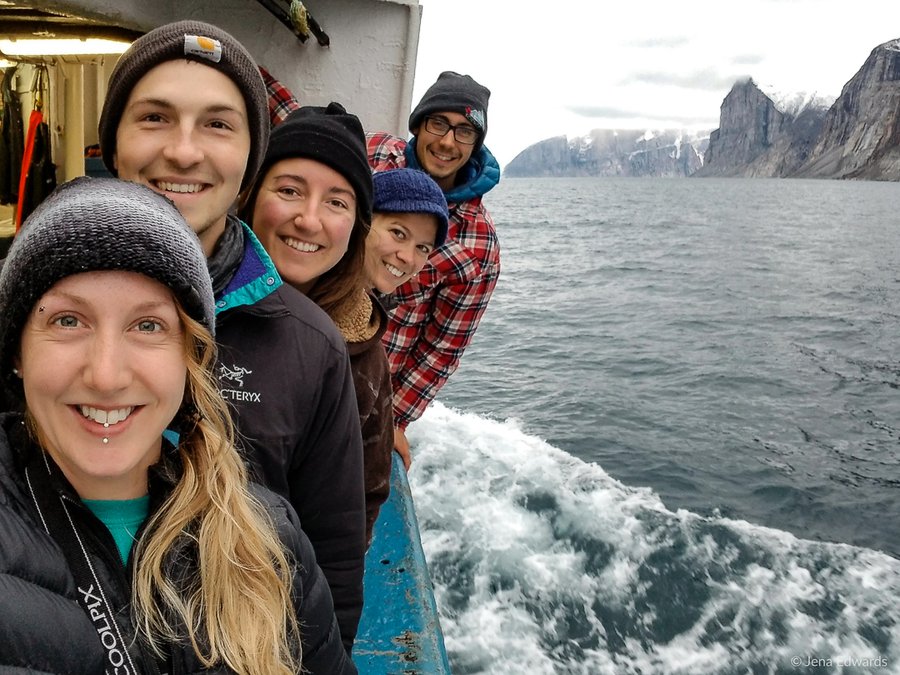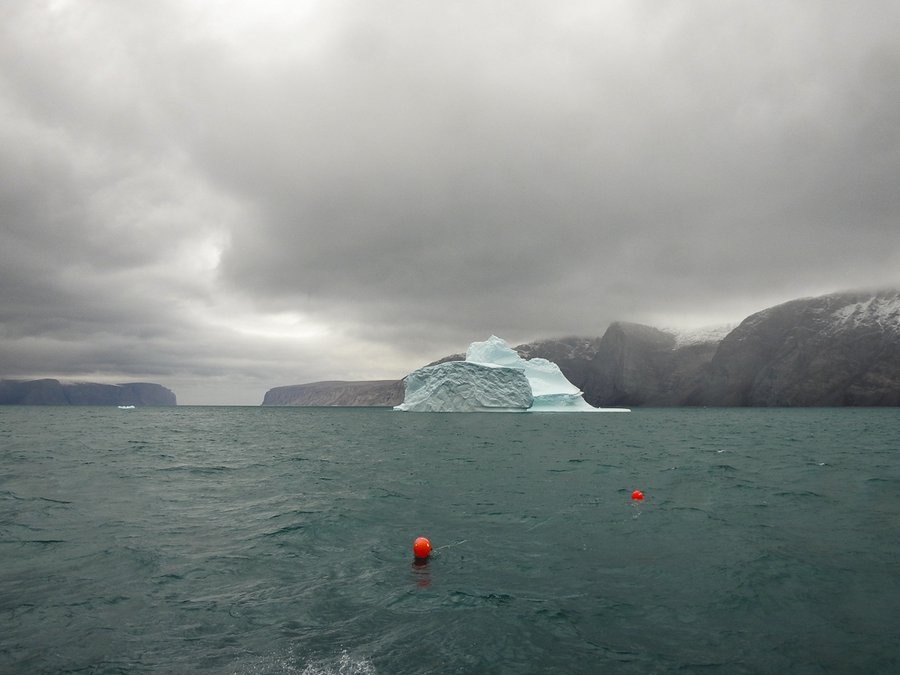
Before the Fall of 2017, I had never expected to find myself aboard a research vessel in Arctic waters.
From our home base in Clyde River, Nunavut, a small bayside community nestled into the eastern shoreline of Baffin Island, we awaited pickup by a commercial longlining vessel, the Kiviuq 1, which emerged into the shallow harbour through a snowy haze. Over the next four weeks, this 30-metre-long ship would serve as both a research lab and home to our team.
Our goal was to ensure the continuation of a long-term project to monitor the movement and habitat use of Greenland halibut, as well as two of its associated bycatch species, the Arctic skate and Greenland shark.
This ongoing research is critical to the sustainability of fisheries and environmental stewardship in the North and the data collected provide a valuable glimpse into the lifestyles of these little-known species.

Greenland shark ‘Gertie’ awaits respirometry trials to measure oxygen consumption rate in holding tank aboard the Kiviuq 1. (Photo: Jena Edwards)
A mysterious and evasive species
In 2016, Danish researchers named the Greenland shark the world’s longest-living vertebrate (with an estimated lifespan of at least 272 y) (1). Until then, this slow moving, deep-dwelling species had received limited interest from the public and was known largely as a nuisance to commercial fisherman.
In addition to being well adapted to the extreme environment of the deep sea, Greenland sharks are one of the few shark species found in polar oceans, and the only one to inhabit the waters of the Eastern Canadian Arctic.
Unlike their more famous temperate and tropical counterparts, Greenland sharks are unique in their incredibly lethargic lifestyle, demonstrating the slowest swim speeds relative to body size of any fish (2) and a remarkably slow metabolic rate (3). Despite their speed (or lack thereof), Greenland sharks are known as important top predators and may play a critical role in providing stability to Arctic marine food webs (4).

A view of the coastline in Scott Inlet, Nunavut. (Photo: Jena Edwards)
However, we still know very little about this deep-sea nomad (5).
Due to its frequent incidental capture, the movement patterns and distribution of Greenland sharks throughout the Canadian Arctic are of major concern for ensuring the sustainability of the commercial Greenland halibut fishery.
Furthermore, efforts to develop Inuit community fisheries through the winter sea-ice rely on an understanding of the seasonal dynamics of the deep-water marine ecosystem, including the behaviour and catchability of Greenland sharks.
"By improving our understanding of Greenland shark movement and habitat use, this research will ultimately guide future assessments of their vulnerability to current and developing fisheries throughout Baffin Bay."
Tracking the movements of Greenland sharks in Baffin Bay
While a growing number of options are now available for tracking the movements of aquatic animals, very few of these technologies are suited for the extreme environment of the deep sea (6).
Our approach, known as static acoustic telemetry, combines the use of animal-borne electronic tags (acoustic transmitters) and an array of moored receiver stations designed to detect the presence of electronically tagged fish as they move throughout the study system.
With the entirety of Baffin Bay as our experimental arena, an array of this scale is no small feat to maintain. Even after its initial setup, significant time and manpower are required to service the array each year, ensuring that the monitoring of our target species continues interannually.

The Fall 2019 research team in Scott Inlet, Nunavut. (Photo: Jena Edwards)
The first priority is the maintenance of the receiver stations. Due to the vastness of our array, every usable minute of the rapidly dwindling daylight hours are required for retrieving, servicing (e.g., downloading data, replacing batteries) and redeploying acoustic receiver stations positioned strategically throughout the study area.
Each station consists of a subsurface float and a long, suspended line which is equipped with an acoustic receiver and environmental sensors that store continuous records of oceanographic data, such as temperature, salinity, and dissolved oxygen.
For most of the year, the stations remain anchored to the sea floor where they are likely to be encountered by our target species. However, once a year they are retrieved using a release mechanism that detaches itself from the anchor, allowing the line and equipment to be brought to the surface, courtesy of the float.

An iceberg floats by a fishing line set to catch Greenland sharks in Scott Inlet, Nunavut. (Photo: Jena Edwards)
While long days and nights in the field can be grueling, the rewards are well worth it. Through the tireless efforts of our research team and our predecessors before us, I was provided with an impressive dataset containing the long-term movement records of 156 Greenland sharks tagged throughout the Eastern Canadian Arctic.
This gave me the unprecedented opportunity to examine Greenland shark movements in both coastal and offshore waters, in order to uncover seasonal patterns in local residency and transient movement behaviours.

An acoustic receiver station ready to be redeployed. (Photo: Jena Edwards)
Connecting seasonal behaviours to sea ice
Upon inspection, these data demonstrated that Greenland sharks, while slow-moving, are capable of undertaking large-scale movements, and that tagged sharks monitored by our study followed regimented seasonal transitions between coastal and offshore habitats. The key to these movements was identified as the most striking seasonally dynamic feature of Arctic marine ecosystems - sea ice.
Like many polar species that use sea ice as a cue to drive movements between seasonally productive habitats, Greenland sharks were found to time their presence among Arctic marine regions to the beat of this climatic drum.
In the summer ice-free months between July and November, tagged sharks were detected in fjords along Baffin Island’s eastern shore after entering through deep-water channels.
Throughout the remainder of the year, when ice re-formation led to the near complete coverage of the ocean basin, these Greenland sharks were then detected in deep waters offshore.
The timing of this seasonal pattern contradicts that of the fishing industry throughout Baffin Bay, wherein commercial fisheries operate through the summer in offshore waters, and community fisheries predominantly operate through the winter land-fast sea ice.
This might suggest that Greenland sharks are largely unavailable to these regional fisheries due to the opposing trend in distribution.

Retrieving an acoustic receiver station in offshore Baffin Bay. (Photo: Jena Edwards)
New advancements for future research
However, despite the predictability of these seasonal movements in our dataset, catch records from commercial and scientific fisheries present a new complication. While tagged Greenland sharks went undetected in the winter months across four coastal sites monitored by our array, published reports show that untagged sharks are in fact present in coastal waters during the ice-covered period (7).
With our relatively large sample size, it is unclear why we fail to see this behaviour exhibited by individuals in our tagged population. We have yet to find the answer, but future efforts aimed at tagging sharks through the winter sea ice in these coastal systems and the comparison of movement records to a wider range of potential environmental drivers (dissolved oxygen, primary production, or prey availability) may reveal an explanation for this discrepancy.
By improving our understanding of Greenland shark movement and habitat use, this research will ultimately guide future assessments of their vulnerability to current and developing fisheries throughout Baffin Bay.
For the ageless Greenland shark, and for those who strive to understand it, the story doesn’t end here. Many more questions remain to be answered and each day new methods are developed which allow scientists to extend their reach to the farthest corners and greatest depths of our oceans.

A seal frolics in the shelter of an iceberg. (Photo: Jena Edwards)
Jena Edwards completed her Master's research with the Hussey Lab of Movement and Trophic Ecology at the University of Windsor.
Additional support for this research was provided by the Goverment of Nunavut, the Nunavut Fisheries Association, Fisheries and Oceans Canada, the Ocean Tracking Network, the National Sciences and Engineering Research Council (NSERC), the Northern Scientific Training Program, and the Garfield Weston Foundation.
References:
- Nielsen, J., Hedeholm, R. B., Heinemeier, J., Bushnell, P. G., Christiansen, J. S., Olsen, J., … Steffensen, J. F. (2016). Eye lens radiocarbon reveals centuries of longevity in the Greenland shark (Somniosus microcephalus). Science, 353(6300), 702–704. https://doi.org/10.1126/science.aaf1703
- Watanabe, Y. Y., Lydersen, C., Fisk, A. T., & Kovacs, K. M. (2012). The slowest fish: Swim speed and tail-beat frequency of Greenland sharks. Journal of Experimental Marine Biology and Ecology, 426–427, 5–11. https://doi.org/10.1016/j.jembe.2012.04.021
- Ste-Marie, E., Watanabe, Y.Y., Semmens, J.M., Marcoux, M., and Hussey, N.E. Extreme in the wild but predictable by theory: the metabolic ecology of the longest-lived vertebrate (In review with Scientific Reports).
- McMeans, B. C., Arts, M. T., Lydersen, C., Kovacs, K. M., Hop, H., Falk-Petersen, S., & Fisk, A. T. (2013). The role of Greenland sharks (Somniosus microcephalus) in an Arctic ecosystem: Assessed via stable isotopes and fatty acids. Marine Biology, 160(5), 1223–1238. https://doi.org/10.1007/s00227-013-2174-z
- Edwards, J.E., Hiltz, E., Broell, F., Bushnell, P. G., Campana, S. E., Christiansen, J. S., … Hussey, N. E. (2019). Advancing research for the management of long-lived species: A case study on the Greenland Shark. Frontiers in Marine Science, 6(APR). https://doi.org/10.3389/fmars.2019.00087
- Edwards, J.E., Pratt, J., Tress, N., & Hussey, N. E. (2019). Thinking deeper: Uncovering the mysteries of animal movement in the deep sea. Deep-Sea Research Part I: Oceanographic Research Papers, 146.https://doi.org/10.1016/j.dsr.2019.02.006
- Walsh, P. (2018). Winter Longline Fishing in Scott inlet/Sam Fjord, Baffin Island. Technical Report. Centre for Sustainable Aquatic Resources, Fisheries and Marine Institute of Memorial University of Newfoundland & Clyde River Hunters and Trappers Association., (March 2008). https://doi.org/10.13140/RG.2.2.26815.76966





